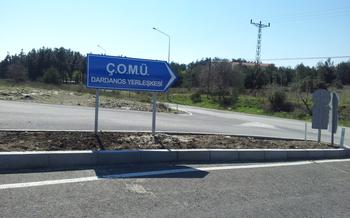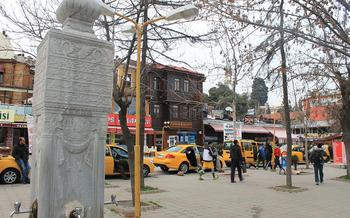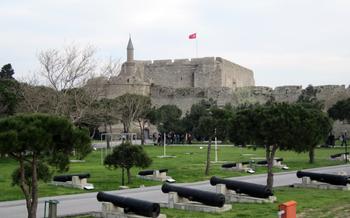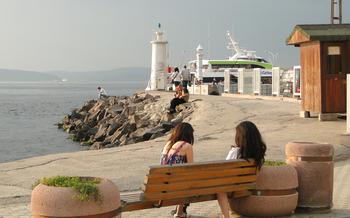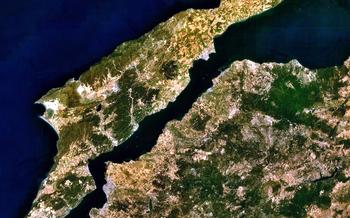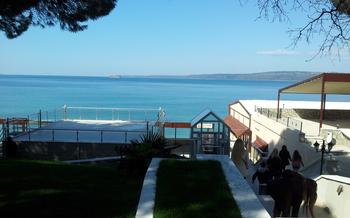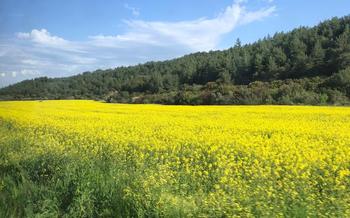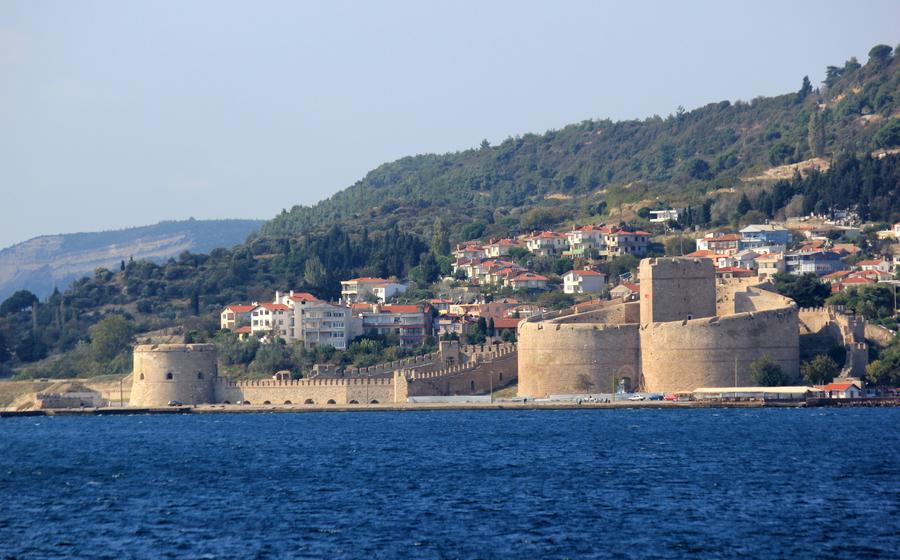
Kilitbahir Fortress
- The Antiquity of Kilitbahir Fortress
- Strategic Importance of Kilitbahir Fortress
- Exploring the Fortress
- Kilitbahir During the Gallipoli Campaign
- The Museum of the Martyrs
- Breathtaking Panoramas from Kilitbahir Fortress
- Kilitbahir Village
- The Role of Kilitbahir Fortress Today
- A Walk Through History
- The Fortress as a Memorial
- Visiting the Fortress
- Exploring the Dardanelles Straits
- The Gallipoli Peninsula
- Other Sites and Memorials
- The Importance of Learning
- Insider Tip: Unveiling the Fortress's Hidden Beauty
The Antiquity of Kilitbahir Fortress
Kilitbahir Fortress stands as a testament to the rich history and strategic significance of the Dardanelles Straits. Its origins can be traced back to the 7th century BC when the Greeks established a settlement called Abydos on the opposite side of the straits. Over time, the fortress underwent several expansions and modifications, reflecting the influence of different civilizations that ruled the region. In the 5th century BC, the Persians constructed a fortified citadel on the site, recognizing its importance as a strategic military outpost. The Byzantines further strengthened the fortress during the 6th century AD, transforming it into a formidable stronghold guarding the entrance to the Dardanelles. These historical layers contribute to the unique architectural heritage of Kilitbahir Fortress, making it a captivating destination for history enthusiasts and travelers seeking to explore the region's ancient past.
Strategic Importance of Kilitbahir Fortress
Protecting passage of the Dardanelles was the primary objective of Kilitbahir Fortress. Its strategic location as a gateway between the Aegean and Black Seas made it a critical military site over the centuries. The Dardanelles, a narrow strait, served as a strategic chokepoint, allowing control over access to the Black Sea and beyond. The fortress, guarding the narrowest point of the strait, played a pivotal role in regulating maritime traffic and defending against potential naval threats. It prevented enemy ships from entering the Sea of Marmara and threatened Constantinople, the capital of the Byzantine and Ottoman Empires. The strategic importance of Kilitbahir Fortress was further highlighted during the Gallipoli Campaign, where it became a critical military objective for the Allied forces. Capturing the fortress would have allowed the Allies to gain control of the Dardanelles and open a sea route to the Black Sea, potentially changing the course of the war.
Exploring the Fortress
Kilitbahir Fortress is a testament to the region's rich history and strategic importance. Its layout reflects its defensive purpose, with thick walls, towers, and ramparts designed to protect against invaders. The fortress's imposing entrance gate leads to a series of courtyards, each with its own defensive features.
Notable landmarks within the fortress include the Keep, a central tower that served as the fortress's command center, and the ramparts, which offer stunning views of the Dardanelles Straits. Visitors can explore the fortress's various chambers, which once housed soldiers and supplies, and marvel at the intricate stonework and architectural details that have stood the test of time.
Despite the fortress's age, it remains in relatively good condition thanks to ongoing restoration efforts. These efforts have focused on preserving the fortress's original features while making it accessible to visitors. Today, Kilitbahir Fortress stands as a living testament to the region's rich military history and offers a glimpse into the lives of the soldiers who once defended its walls.
Kilitbahir During the Gallipoli Campaign
During the ill-fated Gallipoli Campaign of 1915, Kilitbahir Fortress played a pivotal role as a critical military objective for both the Allied forces and the Ottoman defenders. The fortress's strategic location at the narrowest point of the Dardanelles made it a crucial stronghold for controlling the passage of ships and troops.
The Allied forces, comprising British, French, and Australian troops, recognized the strategic importance of Kilitbahir and launched multiple assaults to capture the fortress. However, the Ottoman forces, under the command of Mustafa Kemal Atatürk, mounted a staunch defense, repelling the Allied advances with heavy casualties.
The fighting at Kilitbahir was intense and bloody, with both sides enduring significant losses. The fortress's formidable fortifications and the tenacity of the Ottoman defenders proved too much for the Allied forces, who were unable to breach the fortress's defenses.
The failure to capture Kilitbahir Fortress had a profound impact on the overall outcome of the Gallipoli Campaign. The Allies, unable to secure a foothold on the peninsula, were forced to withdraw their troops, marking the end of the ill-fated campaign.
Despite the ultimate Allied defeat, the heroic defense of Kilitbahir Fortress stands as a testament to the courage and resilience of the Ottoman soldiers. The fortress remains a symbol of Turkish military prowess and a reminder of the sacrifices made by the Turkish people during the Gallipoli Campaign.
The Museum of the Martyrs
Established in 1975 within the Kilitbahir Fortress, the Museum of the Martyrs stands as a solemn tribute to the Turkish soldiers who valiantly fought and sacrificed their lives during the Gallipoli Campaign. With a profound sense of reverence, the museum showcases artifacts, photographs, and personal belongings of these fallen heroes. Visitors can delve into the poignant stories of individual soldiers, gaining a deeper understanding of their unwavering courage and the immense sacrifices they made for their country. The museum serves as a testament to the enduring legacy of these martyrs, honoring their indomitable spirit and reminding visitors of the profound cost of war.
Breathtaking Panoramas from Kilitbahir Fortress
Kilitbahir Fortress offers visitors breathtaking vistas of the Dardanelles Straits and the surrounding landscape. From the fortress's ramparts, you can gaze out at the shimmering blue waters of the straits, dotted with ships and boats of all sizes. The verdant hills and rugged cliffs of the Gallipoli Peninsula form a picturesque backdrop, creating a panoramic vista that is both serene and awe-inspiring.
As the sun dips below the horizon, the fortress transforms into a magical realm bathed in golden light. The sky erupts in a kaleidoscope of colors, from fiery reds and oranges to deep purples and blues. The fortress's silhouette stands out against the vibrant sky, casting long shadows that dance across the water. It's a sight that will leave you spellbound, making it the perfect spot to capture some truly stunning photographs.
Whether you're an avid photographer or simply someone who appreciates natural beauty, the views from Kilitbahir Fortress are not to be missed. Take some time to soak in the scenery, breathe in the fresh air, and let the tranquility of the surroundings wash over you. It's an experience that will stay with you long after you've left this historic fortress.
Kilitbahir Village
In the shadow of the imposing Kilitbahir Fortress lies the quaint and welcoming village of Kilitbahir. A charming tapestry of traditional Turkish life, the village exudes a sense of timeless serenity, where locals embrace visitors with open arms and a genuine warmth that reflects the true essence of Turkish hospitality.
Strolling through the narrow cobbled streets, one is greeted by the vibrant colors of bougainvillea cascading over whitewashed houses, creating a picture-perfect backdrop for your exploration. The air is filled with the tantalizing aromas of freshly baked bread wafting from local bakeries and the gentle hum of daily life.
Take your time to savor the local culture and traditions, which are deeply rooted in this village. Engage in friendly conversations with the villagers, who are always eager to share stories and anecdotes about their lives, their customs, and the rich history of their beloved village.
When hunger strikes, indulge in the culinary delights offered by the village's charming restaurants, serving mouthwatering traditional Turkish cuisine. Freshly caught seafood, succulent kebabs, and delectable pastries are just a few of the culinary treasures waiting to be savored.
Don't miss the opportunity to immerse yourself in the local shopping experience. Browse the colorful stalls and shops, where you can find an array of locally produced crafts, souvenirs, and textiles that reflect the vibrant spirit of Turkish artistry.
Whether you seek a tranquil retreat or an authentic cultural immersion, Kilitbahir Village, nestled in the shadow of its iconic fortress, offers a truly unforgettable experience that will linger in your memories long after your visit.
The Role of Kilitbahir Fortress Today
Kilitbahir Fortress has undergone a remarkable transformation in recent years, evolving from a strategic military site to a popular tourist attraction. Its historical significance and captivating ambiance have drawn visitors from around the world who seek to delve into the depths of Turkish history and military heritage.
The fortress now stands as a living testament to the resilience and patriotism of the Turkish people. It has become a symbol of their unwavering determination to defend their homeland, a beacon of national pride that inspires awe and respect in the hearts of all who visit.
Beyond its historical significance, Kilitbahir Fortress holds immense educational value for those interested in military history. Visitors can explore the fortress's well-preserved battlements, towers, and courtyards, gaining insights into the strategies and tactics employed during the Gallipoli Campaign. The fortress serves as a poignant reminder of the sacrifices made by soldiers on both sides, fostering a sense of empathy and understanding among visitors.
A Walk Through History
Wandering along the fortress walls and battlements of Kilitbahir is a journey through time, transporting visitors back to the days of fierce battles and heroic struggles. The worn stones and weathered ramparts bear witness to the countless footsteps that have traversed these grounds, from ancient warriors to modern-day explorers. As you tread upon the same paths once trodden by soldiers, you can almost hear the echoes of their footsteps and the clash of swords.
Imagine the sentries keeping watch from the lofty towers, their eyes scanning the horizon for any sign of approaching enemies. Picture the soldiers manning the cannons, their hearts pounding as they prepared to unleash a barrage of fire upon the oncoming invaders. Feel the tension in the air as the fortress braces itself for yet another onslaught, its defenders determined to hold their ground against all odds.
With each step, you'll discover remnants of the fortress's rich history. From the sturdy gates that once repelled enemy advances to the secret passageways that allowed defenders to move undetected, every nook and cranny holds a story waiting to be told. The very stones seem to whisper of the bravery, sacrifice, and resilience that unfolded within these walls.
A walk through Kilitbahir Fortress is not just a journey through history; it's an immersive experience that allows you to connect with the past in a tangible way. It's a chance to pay homage to the fallen soldiers who fought valiantly for their country and to gain a deeper understanding of the events that shaped the course of history.
The Fortress as a Memorial
The Kilitbahir Fortress stands as a solemn memorial to the countless Turkish soldiers who lost their lives during the Gallipoli Campaign. Within its walls lie the graves of these fallen heroes, their sacrifices forever etched in the history of the nation. A profound sense of respect and reverence permeates the atmosphere of the fortress, reminding visitors of the immense loss and suffering endured during that fateful period.
The fortress serves as a constant reminder of the bravery, resilience, and determination of the Turkish people in the face of adversity. It is a place where visitors can pay their respects to the fallen soldiers and reflect on the horrors of war. The fortress stands as a poignant symbol of the sacrifices made by those who fought for their country, and its presence ensures that their memory will never be forgotten.
Visiting the Fortress
Visiting Kilitbahir Fortress is a rewarding and educational experience that offers a glimpse into Turkey's rich history and military heritage. The fortress is open to the public daily, with visiting hours typically from 8 am to 6 pm. Admission fees are minimal, and there are discounts for students and seniors.
To make the most of your visit, plan to spend at least two hours exploring the fortress and its surroundings. The best time to visit is during the shoulder seasons (spring and fall) when the weather is pleasant, and there are fewer crowds.
It is also advisable to wear comfortable shoes as there is a lot of walking involved, and some of the paths can be uneven. Remember to bring water and a hat, especially during the summer months.
If you are interested in learning more about the history of the fortress and the Gallipoli Campaign, consider hiring a guide. Guided tours are available in various languages and can be arranged through local tour operators or at the fortress entrance.
Before your visit, check the official website of the fortress or the local tourism office for any special events or exhibitions that may be taking place during your visit. This can enhance your experience and provide additional insights into the fortress's significance.
Exploring the Dardanelles Straits
Beyond the walls of Kilitbahir Fortress, the Dardanelles Straits beckon with their allure and historical significance. Embark on a scenic boat tour or cruise to delve into the captivating beauty of this 61-kilometer-long waterway connecting the Aegean and Black Seas. As you glide along the straits, marvel at the stunning landscapes that unfold, dotted with charming villages, verdant hills, and historical landmarks.
Retrace the path of ancient civilizations and immerse yourself in the rich tapestry of history that permeates the Dardanelles. Discover the remnants of ancient cities, such as Abydos and Sestos, which once thrived on the shores of these straits. Gaze upon the legendary ruins of Troy, immortalized in Homer's epic tales of war and love, believed to be located nearby.
Take advantage of the opportunity to explore other historical sites and landmarks that grace the shores of the Dardanelles. Visit the Gallipoli Peninsula, a poignant reminder of the sacrifices made during World War I, where you can pay your respects at the numerous memorials and cemeteries dedicated to the fallen soldiers.
Indulge in the local culture and savor the flavors of traditional Turkish cuisine at one of the many charming restaurants nestled along the straits. Engage with the friendly locals and learn about their way of life, their customs, and their stories.
Whether you're a history buff, a nature enthusiast, or simply seeking a tranquil escape, the Dardanelles Straits offer an unforgettable experience. Let the gentle sway of the boat lull you into a state of serenity as you immerse yourself in the beauty and history that surround you.
The Gallipoli Peninsula
The Gallipoli Peninsula holds immense historical significance as the site of the Gallipoli Campaign during World War I. This ill-fated campaign, launched by the Allied forces in 1915, aimed to capture Istanbul and knock the Ottoman Empire out of the war. However, the Ottoman forces, led by Mustafa Kemal Atatürk, mounted a fierce resistance, resulting in a bloody stalemate and heavy casualties on both sides.
Other Sites and Memorials
Beyond Kilitbahir Fortress, the Gallipoli Peninsula is dotted with other sites and memorials commemorating the campaign. Visitors can explore the numerous cemeteries and memorials dedicated to the fallen soldiers of both the Allied and Ottoman forces. These memorials serve as a poignant reminder of the sacrifices made during this tragic conflict.
The Importance of Learning
The Gallipoli Peninsula offers a profound opportunity for visitors to learn about the events of the campaign and its significance in world history. By visiting the battlefields, memorials, and museums, visitors can gain a deeper understanding of the strategies, tactics, and human toll of this pivotal conflict. The peninsula serves as a testament to the courage, resilience, and sacrifice displayed by soldiers on both sides.
Insider Tip: Unveiling the Fortress's Hidden Beauty
For a unique perspective on Kilitbahir Fortress, venture beyond the main tourist areas and explore the hidden nooks and crannies that reveal its lesser-known charms. One such spot is the picturesque cove tucked away on the fortress's western side. Accessible via a secluded path, this serene haven offers breathtaking views of the Dardanelles Straits and the surrounding countryside. Capture the essence of the fortress in a panoramic photo, showcasing the rugged battlements against the backdrop of the tranquil waters. For an unforgettable experience, plan your visit during the golden hours of sunset or sunrise, when the sky transforms into a canvas of vibrant hues, casting a magical glow upon the ancient stones.
